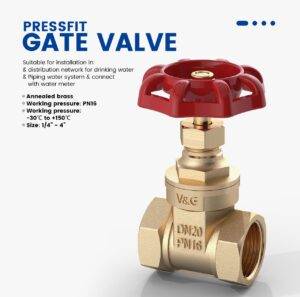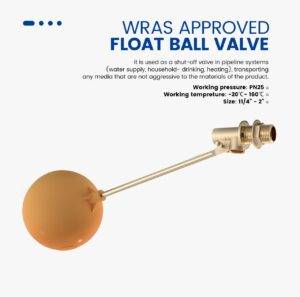When it comes to designing or maintaining a plumbing system, knowing the right types of valves to use is essential. Valves play a critical role in regulating water flow, managing pressure and shutting off supply when needed. From simple household plumbing tasks to large-scale commercial setups, valves keep everything running efficiently and safely. Many people overlook these components but they’re at the heart of every well-functioning plumbing system. Whether you’re fixing a leaky faucet, installing a new water heater or planning a full renovation, having a basic understanding of plumbing valve types can help you make smarter, more cost-effective decisions. In this guide, we’ll walk you through the most commonly used plumbing valves, explain how they work and show where and why you might need each one.
1. Ball Valve

A ball valve uses a hollow, rotating ball to control water flow. When the hole in the ball lines up with the pipe, water flows through. Turning the handle 90 degrees rotates the ball, stopping the flow.
Why It’s Important:
Ball valves are strong, simple and reliable. They offer a complete shut-off with a quick turn. These valves don’t clog easily and work well under high pressure.
Where to Use It:
Install ball valves on main water supply lines, outdoor faucets or anywhere you need fast and secure shut-off. They are great for emergency use and general water control.
2. Gate Valve

Gate valves control flow by lifting or lowering a metal gate inside the valve. When fully open, the gate rises and allows water to pass straight through.
Why It’s Important:
Gate valves allow for full water flow with little resistance. However, they open and close slowly, so they are not ideal for quick shut-offs. You should not use them to adjust flow, only to turn water on or off.
Where to Use It:
You’ll usually find gate valves on underground water lines, main supply lines or any system that needs full flow without restriction.
3. Globe Valve
Globe valves have a plug that moves up and down inside the valve body. As the plug lowers, it blocks the flow of water. Unlike gate valves, globe valves can adjust the amount of water passing through.
Why It’s Important:
These valves are perfect for fine-tuning water pressure and flow. They also close more tightly than gate valves, reducing the risk of leaks.
Where to Use It:
Use globe valves on outdoor faucets, water heaters or shower systems where you want more control over water flow.
4. Check Valve
 Check valves only allow water to flow in one direction. A flap or ball inside the valve closes when water tries to flow backward.
Check valves only allow water to flow in one direction. A flap or ball inside the valve closes when water tries to flow backward.
Why It’s Important:
Check valves protect plumbing systems by stopping backflow. This keeps your drinking water clean and prevents pressure damage.
Where to Use It:
Install check valves near pumps, sump pumps and irrigation systems. They are especially useful in homes with well systems or where water flows upward.
5. Pressure-Reducing Valve (PRV)
 A PRV lowers incoming water pressure from the main water line. It adjusts the flow to match safe levels for home pipes and fixtures.
A PRV lowers incoming water pressure from the main water line. It adjusts the flow to match safe levels for home pipes and fixtures.
Why It’s Important:
High water pressure can damage pipes, cause leaks and shorten the life of appliances. A PRV protects your system and helps reduce water waste.
Where to Use It:
Install PRVs at the point where your main water line enters the house, especially if your area has strong municipal water pressure.
6. Angle Stop Valve

An angle stop valve controls water flow to a specific fixture, like a sink or toilet. The valve has a 90-degree angle, allowing it to fit neatly behind appliances.
Why It’s Important:
Angle valves make repairs or upgrades easy. You can shut off water to a single area without affecting the entire system.
Where to Use It:
Place angle stop valves under bathroom sinks, behind toilets or under kitchen fixtures. They are very common in households.
7. Butterfly Valve
Butterfly valves use a rotating metal disc to block or allow flow. Turning the handle rotates the disc in the center of the pipe.
Why It’s Important:
These valves are compact, quick to operate and ideal for large pipes. They handle high flow rates well and are easy to maintain.
Where to Use It:
You’ll often find butterfly valves in commercial plumbing systems, large-scale irrigation and industrial water treatment plants.
8. Stop Valve
A stop valve is similar to an angle valve but can come in straight or angled forms. It shuts off water to a specific part of the plumbing.
Why It’s Important:
Stop valves are small, easy to use and helpful for minor plumbing work. You can isolate fixtures without turning off the entire home’s water supply.
Where to Use It:
Use stop valves for dishwashers, washing machines or individual water outlets.
9. Float Valve

Float valves open or close based on water level. A floating ball attached to the valve rises with water and shuts the valve when the desired level is reached.
Why It’s Important:
These valves control water automatically and prevent overfilling, making them ideal for systems that store or recycle water.
Where to Use It:
You’ll find float valves in toilet tanks, water storage tanks and cooling systems.
10. Hose Bib (Bibcock)

A hose bib is an outdoor faucet where you attach garden hoses. It has a threaded spout for easy connection and shut-off.
Why It’s Important:
Hose bibs give you easy access to water outside your house. They’re simple to operate and very durable.
Where to Use It:
Install hose bibs on exterior walls for gardening, car washing or filling outdoor containers.
Final Thoughts
Understanding the different types of plumbing valves is more than just useful—it’s essential for anyone dealing with water systems, whether at home or in a commercial setting. Each valve serves a specific purpose and choosing the right one can make a big difference in the performance, safety and longevity of your plumbing setup. From the easy-to-use ball valve to the precise needle valve, every type has a role based on flow control, pressure requirements and system design.
Taking the time to learn about these valves helps you troubleshoot issues more effectively, plan plumbing projects with confidence and communicate better with plumbers or contractors. It also empowers you to make smarter purchasing decisions when replacing or upgrading parts.
Always consider key factors like the material of the valve, compatibility with water temperature and pressure and the location where the valve will be installed. These small but crucial details ensure your system runs smoothly and avoids costly mistakes down the line.
Whether you’re a DIY enthusiast or a professional plumber, knowing your plumbing valves is a skill that pays off in both time and money. If you want more helpful guides and tips, be sure to check out our other plumbing articles.



1 Comment
Arlie
June 12, 2025Every weekend i used to pay a quick visit this web page, because i want enjoyment,
as this this website conations really good funny
material too.